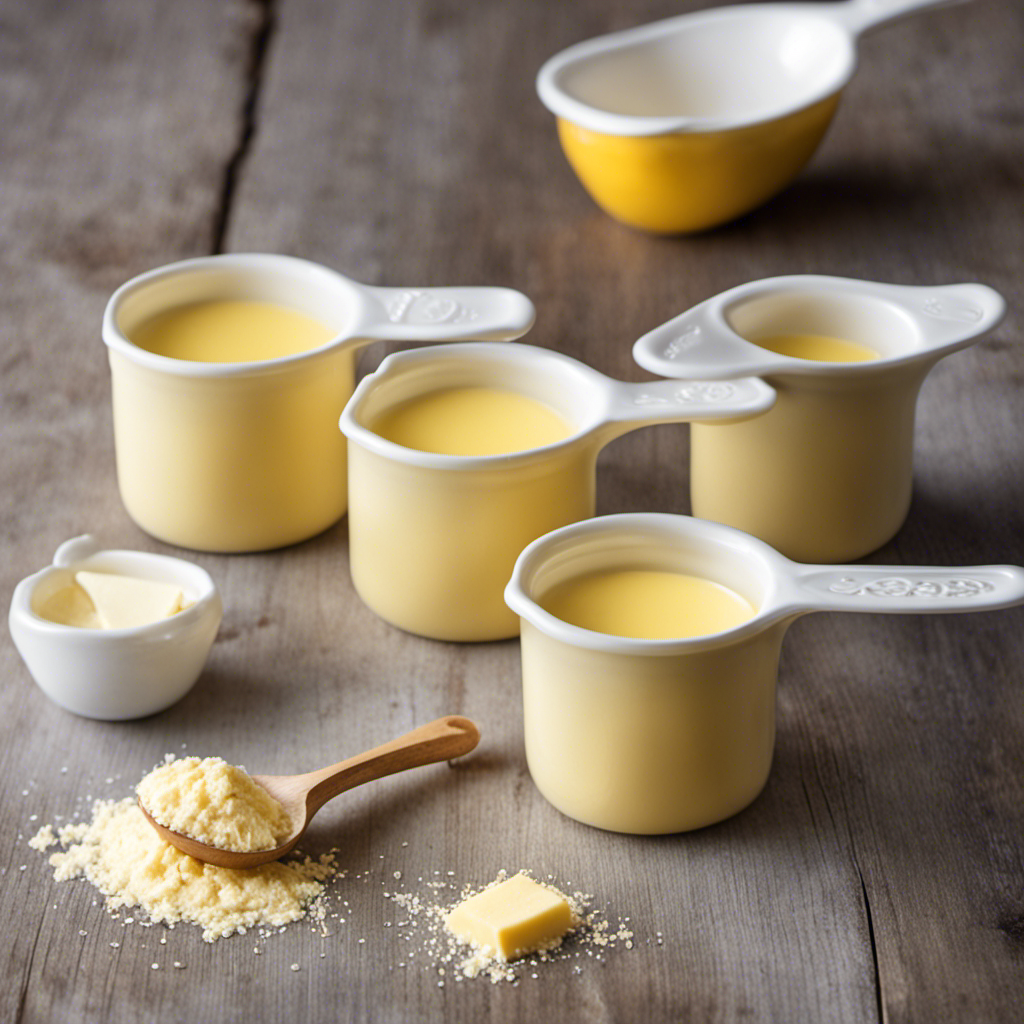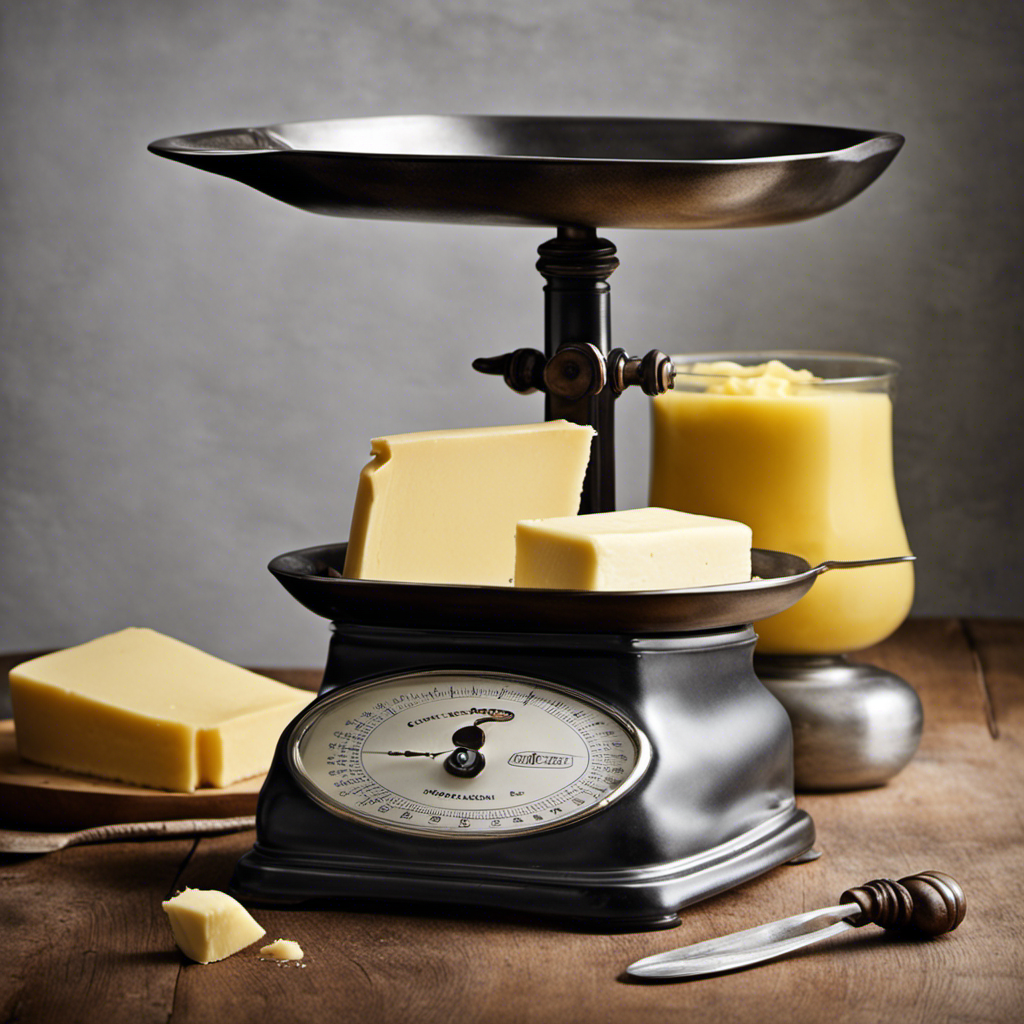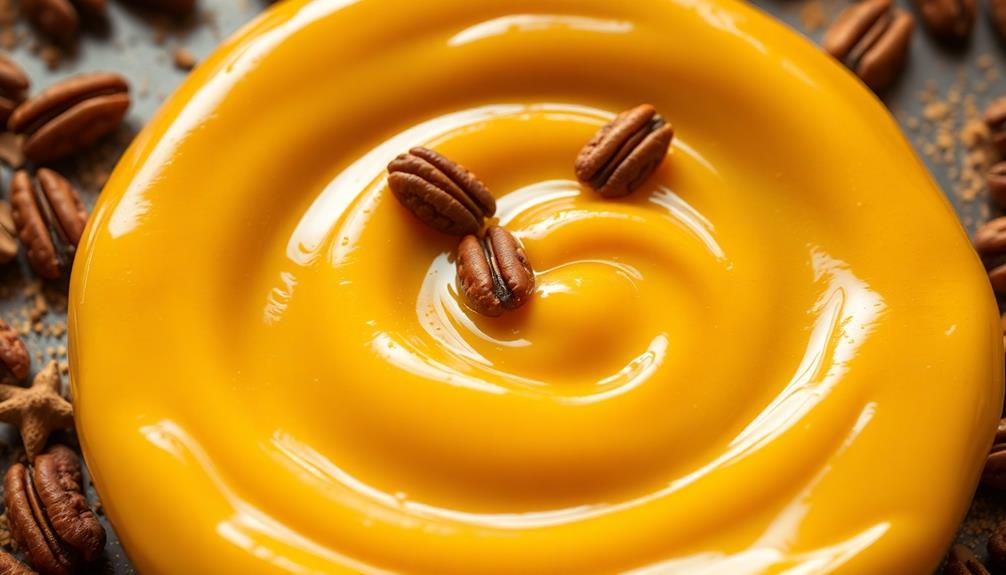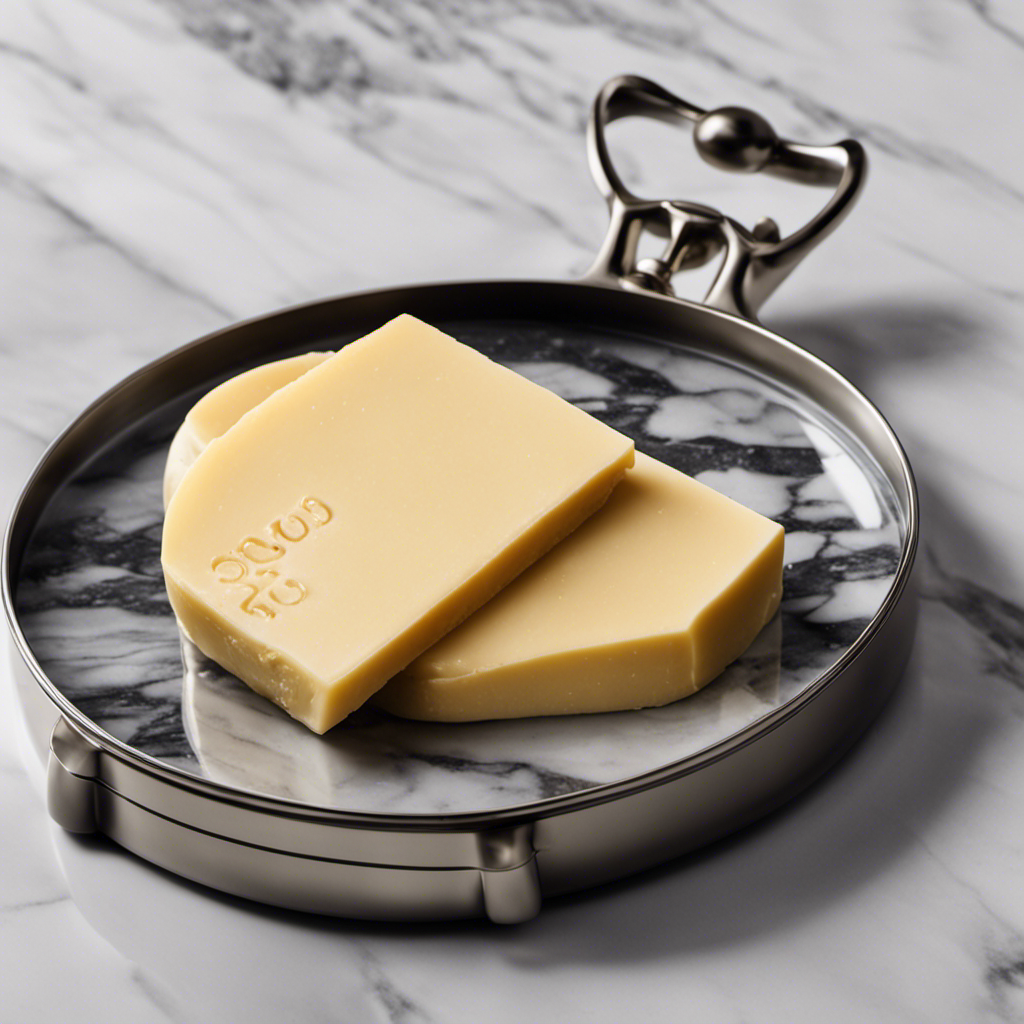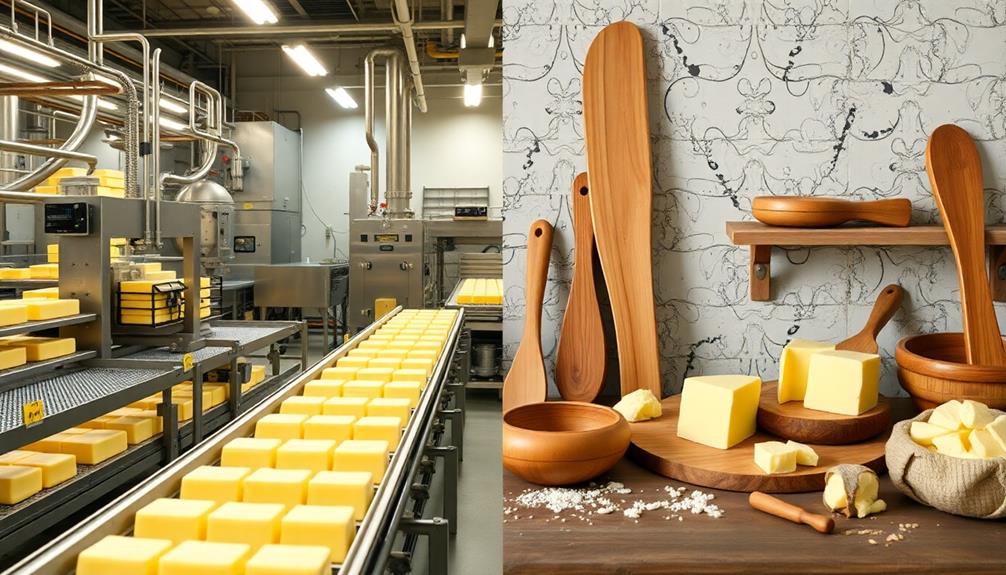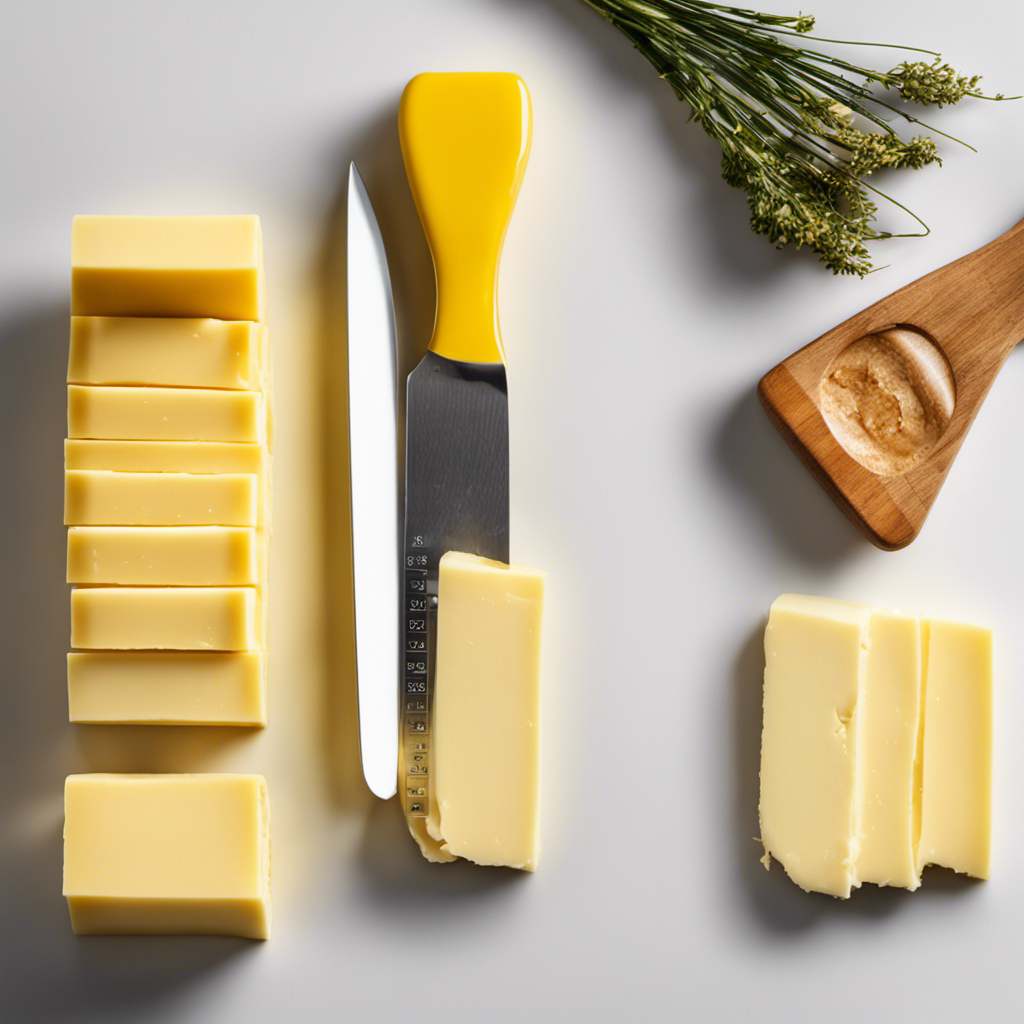Frequently, I find myself in the midst of preparing a recipe in the kitchen, only to discover that I lack the specific utensil required. This can be particularly annoying when dealing with fundamental ingredients, like butter.
So, how many tablespoons equal 2/3 cup of butter? In this article, I’ll break down the conversion ratio, explain the importance of measuring accurately, and provide tips for properly measuring butter.
Get ready to become a master of butter conversions in no time!
Key Takeaways
- 2/3 cup of butter is approximately 150 grams or 5.3 ounces.
- To convert tablespoons to cups, divide the number of tablespoons by 16.
- Use the correct measuring tools and level off the tablespoon or cup for accurate measurement.
- Different ingredients have different conversion ratios from tablespoons to grams, so use a reliable conversion chart or online calculator for accurate measurements.
Understanding the Conversion Ratio
To understand the conversion ratio, you’ll need to know how many tablespoons are equivalent to 2/3 cup of butter. Converting grams to tablespoons can be a bit tricky, as the density of different substances can vary. However, for butter, the general rule is that 1 tablespoon is equal to approximately 14 grams. So, if you have 2/3 cup of butter, which is about 150 grams, you can divide it by 14 to get the number of tablespoons. In this case, it would be around 10.7 tablespoons.
When converting ounces to cups, the conversion is a bit more straightforward. There are 8 ounces in a cup, so if you have 2/3 cup of butter, it would be about 5.3 ounces. You can then multiply this by the conversion factor of 2 tablespoons per ounce to find that it is approximately 10.6 tablespoons.
Now that we have covered converting grams to tablespoons and ounces to cups, let’s move on to converting cups to tablespoons.
Converting Cups to Tablespoons
I find it helpful to understand the conversion ratio for butter when calculating tablespoons from cups. This knowledge allows me to accurately measure the right amount of butter for my recipes.
Additionally, I have discovered a few tips that ensure my measurements are precise. For example, I always use level measurements and the proper tools for measuring ingredients.
Conversion Ratio for Butter
You can easily convert tablespoons to cups by using a simple ratio. To understand the conversion ratio, keep in mind that there are 16 tablespoons in one cup. So, if you want to convert tablespoons to cups, divide the number of tablespoons by 16.
For accurate measurement, it is important to use the correct measuring tools. Make sure to level off the tablespoon or cup with a straight edge to get an accurate amount. When measuring liquids, place the measuring cup on a flat surface and check the measurement at eye level for precision.
Understanding this conversion ratio and following these tips will ensure accurate measurements when converting tablespoons to cups.
Now, let’s move on to calculating tablespoons from cups.
Calculating Tablespoons From Cups
If using a measuring spoon, make sure to level it off with a straight edge for accurate calculations. Converting metric units can be a useful skill in the kitchen, especially when following recipes that use different measurements. When converting tablespoons to grams, it’s important to remember that the conversion ratio may vary depending on the ingredient.
Here are some key points to consider:
- Different ingredients have different conversion ratios from tablespoons to grams.
- To convert tablespoons to grams, multiply the number of tablespoons by the conversion ratio specific to the ingredient.
- Use a reliable conversion chart or online calculator for accurate measurements.
- Keep in mind that the weight of a tablespoon may vary depending on the density of the ingredient.
- Double-check your conversions to ensure precise and consistent measurements.
Tips for Accurate Measurement
Using a reliable scale is essential for precise and consistent measurements in the kitchen. When it comes to understanding tablespoons and measuring butter accurately, having the right tools is crucial.
To measure butter accurately, I recommend using a kitchen scale that allows you to switch between grams and ounces. Start by placing a bowl on the scale and then zero it out. Next, add the desired amount of butter and record the weight in grams or ounces. This method ensures accuracy and eliminates guesswork.
The Importance of Measuring Accurately
Measuring accurately is crucial when determining the correct amount of butter for a recipe. Understanding accuracy and employing proper measuring techniques ensures that your dish turns out as intended. Here are some key points to remember:
- Use a reliable measuring tool, such as a measuring cup or scale, to ensure precise measurements.
- Be mindful of the unit of measurement specified in the recipe. In the case of butter, it is often given in tablespoons or cups.
- Soften the butter to room temperature before measuring to ensure consistency.
- For solid butter, use a knife to level off the butter in the measuring cup, ensuring an accurate measurement.
- For melted butter, use a liquid measuring cup, ensuring you fill it to the appropriate mark.
Using a Measuring Cup for Butter
When softening butter for baking, it’s important to bring it to room temperature first. To measure butter accurately, I always use a measuring cup specifically designed for butter. These measuring cups have markings that correspond to tablespoons, making it easy to measure the exact amount needed.
When choosing the right measuring utensil, it’s crucial to consider the size and shape of the cup. I prefer a measuring cup with a wide mouth and a flat base, as it allows me to easily scoop and level off the butter. This ensures that I am getting the precise measurement required for my recipe.
Converting Fractions to Decimals
Now that we know how to use a measuring cup for butter, let’s move on to converting fractions to decimals. This is an important skill to have when working with recipes that require precise measurements. Here are some conversion techniques to help you out:
-
Divide the numerator by the denominator: For example, to convert 2/3 to a decimal, divide 2 by 3, which equals approximately 0.6667.
-
Use a calculator: If you’re not comfortable with mental math, you can always use a calculator to get an accurate decimal representation.
-
Memorize common conversions: Some fractions, like 1/2 or 1/4, have commonly used decimal equivalents. Memorizing these can save you time and effort in the kitchen.
-
Round to a desired decimal place: Depending on the level of precision you need, you can round the decimal to a specific place value.
-
Practice, practice, practice: The more you practice converting fractions to decimals, the easier it will become.
The Mathematics Behind the Conversion
When it comes to converting measurements, understanding the conversion formula is key.
In this discussion, we will delve into the explanation of the conversion formula, breaking it down step by step to ensure clarity.
Additionally, we will address common measurement mistakes that can occur during the conversion process, providing insights on how to avoid them for accurate results.
Conversion Formula Explained
To convert tablespoons to cups, you can use the formula 16 tablespoons equals 1 cup. This conversion is useful when converting measurements in recipes or when trying to determine the amount of ingredients needed for a specific dish.
Here are some key conversions to keep in mind:
-
Converting grams to tablespoons: This conversion varies depending on the ingredient. For example, 1 gram of water is approximately equal to 0.067 tablespoons, while 1 gram of flour is approximately equal to 0.06 tablespoons.
-
Converting butter from ounces to cups: 1 ounce of butter is equal to approximately 0.125 cups. Therefore, if you have 2/3 cup of butter, it would be equivalent to 5.33 ounces.
Understanding these conversions can help ensure accuracy in your cooking and baking. However, it’s important to be aware of common measurement mistakes that can occur. Now, let’s explore some of these mistakes and how to avoid them.
Common Measurement Mistakes
Be careful not to make these common measurement mistakes in your cooking and baking. It’s easy to overlook the importance of accurate measurements when following a recipe, but it can greatly impact the outcome of your dish.
One common mistake is using the wrong measuring tools. It’s crucial to use the appropriate cups and spoons for liquid and dry ingredients.
Another mistake is not leveling off your measurements. When measuring flour or sugar, make sure to level off the top with a straight edge to ensure accuracy.
Additionally, eyeballing measurements can lead to inconsistencies. Always use measuring tools for precise results.
Lastly, be mindful of using the correct unit of measurement. For example, tablespoons and teaspoons are not interchangeable.
Converting Cups to Ounces
You can easily convert cups to ounces by multiplying the cup measurement by 8. This conversion is useful when you need to switch between these two common measurements in cooking and baking.
Here are some key points to keep in mind when converting cups to ounces:
- Multiply the cup measurement by 8 to get the equivalent in ounces.
- For example, 1 cup is equal to 8 ounces, and 3/4 cup is equal to 6 ounces.
- This conversion is particularly helpful when working with recipes that provide measurements in cups but require an accurate weight.
- Remember that this conversion applies to liquids and dry ingredients alike.
- If you need to convert cups to grams, you will need to consult a conversion chart as the conversion factor is different.
When it comes to converting butter from ounces to tablespoons, keep in mind that 1 ounce is equal to 2 tablespoons. So, if you have 8 ounces of butter, it would be equivalent to 16 tablespoons.
The Difference Between Salted and Unsalted Butter
When using butter in recipes, it’s important to understand the difference between salted and unsalted.
Salted butter is simply butter that has been mixed with salt, while unsalted butter is butter without any added salt.
The main reason for this distinction is control over the saltiness of the final dish.
If you’re using salted butter in a recipe that calls for salt, you may need to adjust the amount of salt you add to compensate for the salt already present in the butter.
On the other hand, if a recipe calls for unsalted butter and you only have salted butter on hand, you can reduce the amount of added salt to maintain the desired level of saltiness.
Adjusting Recipes for Different Measurements
When it comes to adjusting recipes for different measurements, there are a few key tips and substitutions that can come in handy.
One important tip is to always have a reliable conversion chart on hand, as this will help you accurately convert measurements such as cups to grams or tablespoons to milliliters.
Additionally, knowing common measurement substitutions can help you make healthier or dietary-friendly versions of your favorite recipes. For example, using Greek yogurt instead of sour cream or applesauce instead of oil.
Having these tips and substitutions in mind will make adjusting recipes a breeze.
Conversion Tips for Recipes
To make conversions easier in recipes, it’s helpful to know that 2/3 cup of butter is equal to 10 2/3 tablespoons. Understanding recipe conversions is essential for accurate baking.
Here are some tips to ensure your measurements are precise:
- Use a kitchen scale: Weighing ingredients is more accurate than using volume measurements.
- Convert units consistently: Stick to one measurement system, either imperial or metric, throughout the recipe.
- Know your conversions: Familiarize yourself with common conversions, such as cups to tablespoons, to make adjustments on the fly.
- Adjust for altitude: High altitudes can affect baking times and ingredient ratios, so make necessary adjustments for optimal results.
- Test for doneness: Use visual cues and a toothpick test to determine if your baked goods are fully cooked.
Common Measurement Substitutions
Understanding common measurement substitutions is essential for adapting recipes to fit your needs and available ingredients. One common substitution is converting grams to ounces. Instead of relying on volume measurements like cups or tablespoons, using weight measurements can provide more accuracy in your recipes.
Converting grams to ounces is relatively simple. One gram is equal to 0.035 ounces, so you can multiply the number of grams by 0.035 to get the equivalent in ounces. This can be particularly helpful when dealing with ingredients like flour or sugar, where precision is crucial.
Now that we have covered converting grams to ounces, let’s move on to another common substitution: converting butter from sticks to cups.
Converting Butter From Sticks to Cups
Converting butter from sticks to cups is a simple process. If you ever find yourself in need of this conversion, follow these steps:
- Step 1: Determine the number of sticks of butter you have.
- Step 2: Use the conversion ratio of 1 stick of butter equals 1/2 cup.
- Step 3: Multiply the number of sticks by 1/2 to get the equivalent number of cups.
- Step 4: For example, if you have 4 sticks of butter, you would multiply 4 by 1/2 to get 2 cups of butter.
- Step 5: Use a measuring cup to accurately measure the converted amount of butter.
Converting butter from grams to cups is a bit more complex, as it depends on the density of the butter. However, there are conversion charts available online that can help you with this process.
When it comes to butter substitutes, some of the best options include margarine, coconut oil, and olive oil. These substitutes can be used in various recipes and provide a similar texture and flavor to butter. Experimenting with different substitutes can help cater to dietary restrictions or personal preferences.
Tips for Properly Measuring Butter
One way to ensure accurate measurements is by using a kitchen scale to weigh the butter.
When it comes to baking, precise measurements are crucial for achieving the perfect result. If a recipe calls for a certain amount of butter, it’s important to measure it correctly to ensure the right balance of flavors and textures.
When using a kitchen scale, simply place a bowl on the scale, reset it to zero, and then add the desired amount of butter. This method allows for easy conversion between different units of measurement and ensures accuracy in your recipes.
By adjusting the amount of butter in your recipes, you can easily modify the flavor and texture of your baked goods to suit your personal preferences.
Frequently Asked Questions
Can I Use Margarine Instead of Butter in Recipes That Call for Tablespoons of Butter?
I prefer using butter over margarine in recipes that call for tablespoons of butter. Butter has a richer taste and performs better in baking. Margarine may work as a substitute, but it can affect the flavor and texture of the final result.
How Do I Convert Tablespoons of Butter to Grams or Ounces?
To convert tablespoons of butter to grams or ounces, you can use conversion charts or online calculators. There are also alternative options like using margarine or oil as substitutes in recipes that call for tablespoons of butter.
What Is the Difference Between Unsalted Butter and Salted Butter in Terms of Taste and Cooking?
Unsalted butter and salted butter have different taste and cooking properties. The unsalted butter is great for baking and allows you to control the saltiness in your dish. Salted butter, on the other hand, adds a nice savory flavor when used in cooking.
How Can I Adjust a Recipe That Calls for 2/3 Cup of Butter if I Only Have Sticks of Butter?
To adjust a recipe calling for 2/3 cup of butter when using sticks of butter, I measure out 10 and 2/3 tablespoons. Each stick is equivalent to 8 tablespoons, so 1 and 1/3 sticks should do the trick.
Are There Any Tips for Measuring Butter Accurately, Especially When It Comes to Sticky or Soft Butter?
Measuring soft butter accurately can be tricky, but here are some tips for sticky butter. Start by chilling the butter slightly, then use a knife to gently scrape off tablespoons until you reach 2/3 cup.
Conclusion
So there you have it, measuring butter accurately is crucial when following a recipe. Whether you’re converting cups to tablespoons or adjusting measurements for different types of butter, precision is key.
Just like a painter meticulously mixing colors on their palette, measuring butter with care ensures that your culinary creation turns out just right.
So next time you’re in the kitchen, take the time to measure your butter properly and watch as your dishes come to life, like a beautiful masterpiece.
